Football Tactics
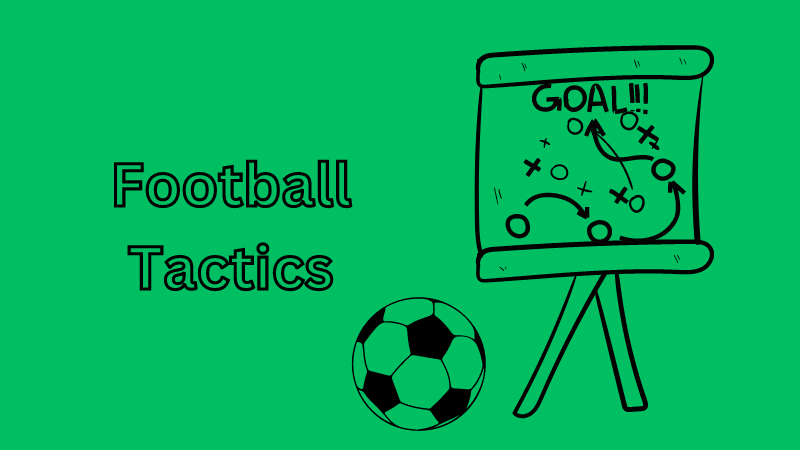
If you like football and want to know more about this game, then look no further because this article covers the best 5 football tactics you can use.
Football Tactics Explained
Find detailed explanations of the best football tactics down below, but don’t forget that football has a lot of fun facts.
Formation Tactic
Formation in football is like a blueprint showing where each player should be positioned on the field. It’s like how you plan your moves in chess. Different formations have different numbers, like 4-4-2 or 3-5-2. These numbers represent the number of players in three different lines: defense, midfield, and attack.
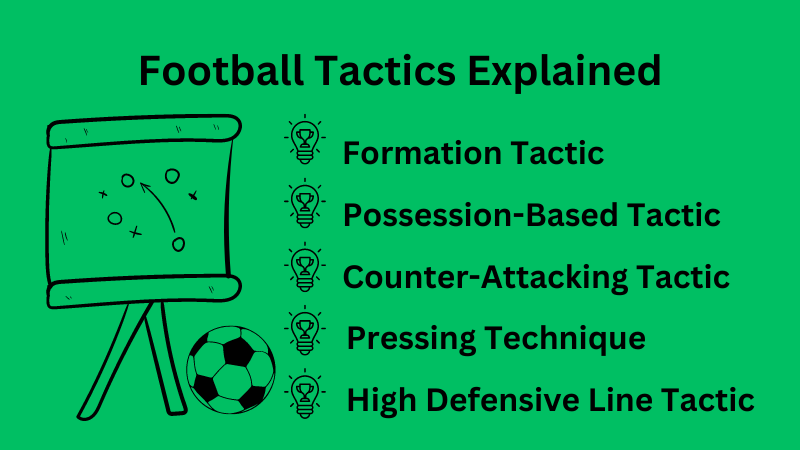
Defense
This is the line of players closest to their own goal, and their job is to stop the other team from scoring.
The number in the formation tells you how many players are in this line. For example, in a 4-4-2 formation, there are four defenders.
Midfield
This line is between the defenders and the attackers in the middle of the field. These players are like the team’s engine room, controlling the flow of the game.
Again, the number in the formation tells you how many players are in this line. So, in a 4-4-2 formation, there are four midfielders.
Attack
These are the players closest to the opponent’s goal, and their job is to score goals. Like the other lines, the number in the formation tells you how many players are in this line. In a 4-4-2 formation, there are two attackers.
Common formations
4-4-2
This is a classic formation with four defenders, four midfielders, and two attackers. It’s balanced, with enough players in defense to stop the other team and enough attackers to score goals.
4-3-3
In this formation, there are four defenders, three midfielders, and three attackers. It’s more attacking than a 4-4-2 because more players are pushing forward.
3-5-2
This formation has three defenders, five midfielders, and two attackers. It’s very flexible because it has many midfield players who can control the game.
Coaches choose different formations based on their team’s strengths and weaknesses and the style of play they want to use.
For example, if a team has fast wingers, they might use a formation with three attackers to take advantage of their speed.
Formations can also change during a game. For example, if a team is losing, they might switch to a more attacking formation to try and score goals. Or if they’re winning, they might switch to a more defensive formation to protect their lead.
So, in summary, a football formation is like a plan that shows where each player should be on the field. It’s made up of three lines: defense, midfield, and attack, and the numbers in the formation tell you how many players are in each line.
Possession-Based Tactic
Possession-based football is like playing keep-away but with a purpose. Instead of just kicking the ball around, teams focus on controlling the ball for as long as possible to create scoring opportunities.
It’s all about passing the ball quickly and accurately while moving around to find openings in the other team’s defense.
Here’s how it works:
Keep the Ball
The main goal of possession-based football is to keep the ball away from the other team. Players pass the ball to each other, always looking for the safest option to maintain control.
It’s like a game of hot potato, but players keep passing it around instead of dropping it.
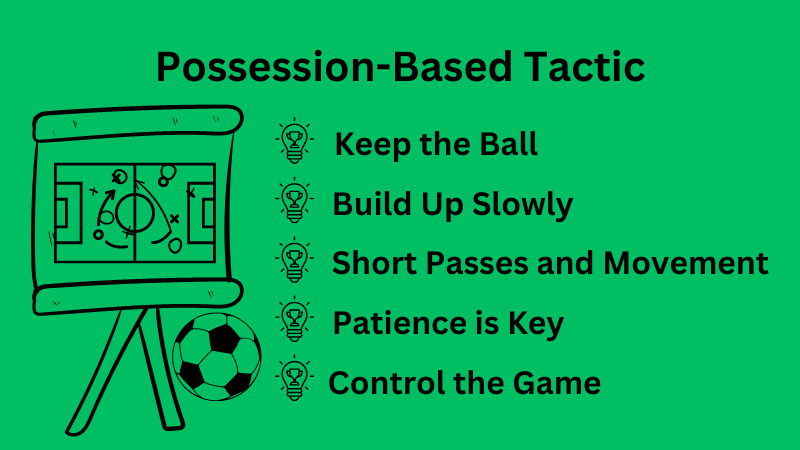
Build Up Slowly
Possession-based teams don’t rush things. They take their time, patiently building up their attacks from the back.
This means passing the ball around in their half, waiting for the right moment to move forward. It’s like slowly building a house, laying each brick carefully to ensure it’s strong and sturdy.
Short Passes and Movement
Players in possession-based teams are always on the move. They constantly pass and move, trying to create space and openings in the other team’s defense. It’s like a dance, with players constantly shifting and changing positions to keep the other team guessing.
Patience is Key
Possession-based football requires patience. Sometimes, it might seem like nothing is happening, but that’s okay.
The team is just waiting for the right moment to strike. It’s like waiting for the perfect wave when surfing, knowing that when it comes, you’ll be ready to ride it to shore.
Control the Game
Possession-based teams control the game’s flow by keeping possession of the ball. They dictate the pace and rhythm, forcing the other team to react to them. It’s like being an orchestra conductor, guiding each player to play their part in harmony.
So, possession-based football controls the game through precise passing, movement, and patience. It’s a strategic approach that requires teamwork and skill but can be incredibly effective when executed well.
Counter-Attacking Tactic
Counter-attacking in football is like turning defense into offense in the blink of an eye. It’s all about waiting for the perfect moment to strike and launching a rapid attack when the other team least expects it.
Here’s how it works:
Defensive Setup
When a team uses a counter-attacking strategy, they often sit back and defend deep in their own half.
They allow the other team to possess the ball and focus on staying organized defensively. It’s like luring the opponent in, making them think they have control of the game.
Quick Transition
Once the counter-attacking team wins the ball back, they spring into action. They transition from defense to attack in the blink of an eye, catching the other team off guard. It’s like flipping a switch, going from defending to attacking in an instant.
Exploiting Space
The key to counter-attacking is speed and precision. The team moves the ball forward quickly, looking to exploit any gaps or spaces left by the other team’s defenders. It’s like finding a hole in the opponent’s armor and striking where they’re most vulnerable.

Fast Breaks
Counter-attacking often involves fast breaks, with players rushing forward in numbers to overwhelm the other team’s defense. It’s like a lightning bolt, sudden and unstoppable, as players sprint towards the opponent’s goal with the ball at their feet.
Clinical Finishing
Once they’re in front of the opponent’s goal, counter-attacking teams aim to be clinical with their finishing. They don’t waste chances because they know they might not get many opportunities. It’s like a sniper taking aim, picking their spot and firing with precision.
Risk and Reward
Counter-attacking is a high-risk, high-reward strategy. It requires patience and discipline to defend deep and wait for the right moment to attack. But when executed well, it can lead to devastating counter-attacks and quick goals that catch the other team by surprise.
So, counter-attacking in football is about turning defense into offense in the blink of an eye. It’s a strategy that relies on speed, precision, and timing to catch the other team off guard and capitalize on scoring opportunities.
Pressing Technique
Pressing in football is like swarming bees around honey – it’s all about putting pressure on the opponent when they have the ball, trying to force them into making mistakes, and winning possession back quickly:
Hunting in Packs
When a team is pressing, players work together to close down the opponent who has the ball. They move quickly and aggressively to pressure the player with the ball, trying to limit their time and space to make decisions. It’s like a pack of hungry wolves hunting their prey.
Cutting off Passing Lanes
Pressing isn’t just about going after the player with the ball – it’s also about cutting off passing lanes. Association players position themselves strategically to block off options for the opponent to pass to, forcing them into making risky or misplaced passes. It’s like building a wall around the opponent, leaving them nowhere to go.
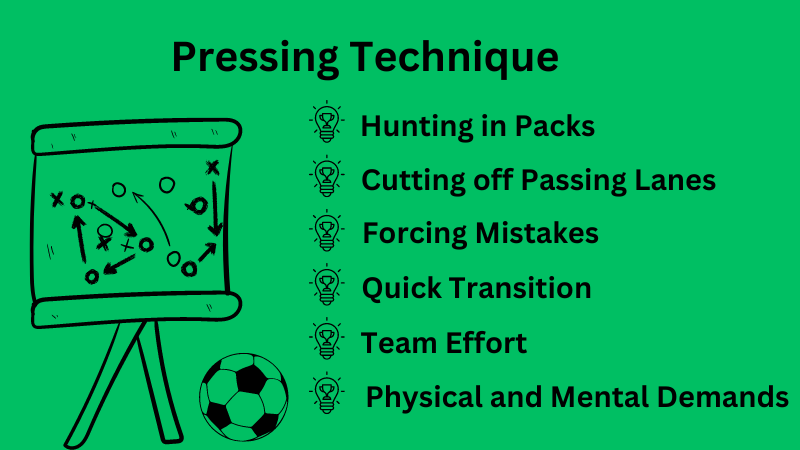
Forcing Mistakes
The ultimate goal of pressing is to force the opponent into making mistakes. Whether it’s a misplaced pass, a heavy touch, or a hurried decision, pressing creates pressure situations that can lead to turnovers in possession.
It’s like applying constant pressure until the opponent cracks under the strain.
Quick Transition
When the pressing team wins the ball back, they look to transition quickly from defense to attack. Because they’ve already got players high up the pitch, they’re well-placed to launch fast counter-attacks and catch the other team off guard. It’s like turning defense into offense in the blink of an eye.
Team Effort
Pressing requires teamwork and coordination from every player on the team. Everyone needs to be on the same page, effectively moving together and closing down space. It’s like a symphony, with each player playing their part in perfect harmony.
Physical and Mental Demands
Pressing is physically demanding because it requires players to cover much ground and constantly be on the move. But it’s also mentally demanding because players must stay focused and disciplined, avoiding getting pulled out of position. It’s like a test of endurance and concentration rolled into one.
So, pressing in football is a proactive defensive strategy that aims to disrupt the opponent’s build-up play and win possession back quickly. It’s all about intensity, coordination, and forcing mistakes to gain the upper hand in the game.
High Defensive Line Tactic
A high defensive line in football is like drawing a line in the sand closer to the opponent’s territory. Teams that use this tactic position their defensive line further up the field, reducing the space between their defenders and the halfway line:
Pushing Up – One of the Football Tactics
Instead of staying close to their goal, defenders move up the field, positioning themselves closer to the halfway line or even beyond it. This reduces the space between the defenders and the opponent’s attackers, making it harder for the other team to play through.
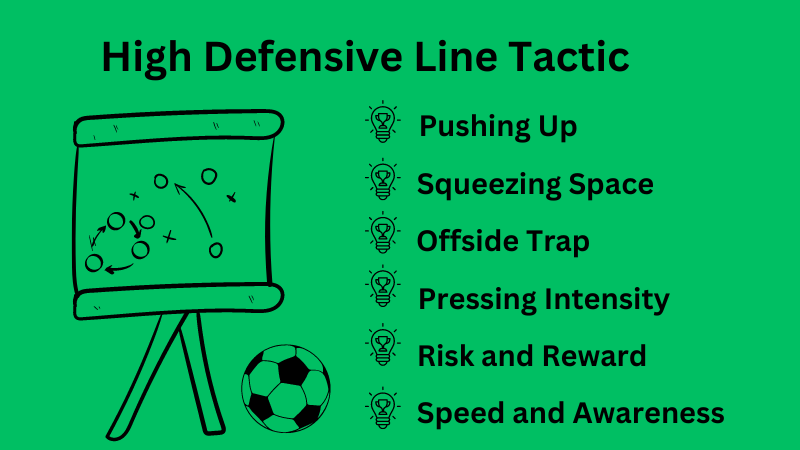
Squeezing Space
Teams compress the playing area by pushing their defensive line higher up the field. This means there’s less space for the opponent’s attackers to operate in, making it more difficult for them to find gaps or run behind the defense. It’s like shrinking the field, making it feel smaller and more congested for the other team.
Offside Trap
One of the key tactics used with a high defensive line is the offside trap. Defenders move up the field together in unison, timing their movements to catch opposing attackers offside. This means they step forward just as the ball is played, catching attackers in an offside position and forcing turnovers in possession.
Pressing Intensity
Teams that use a high defensive line often pair it with aggressive pressing tactics.
By pushing up the field and putting pressure on the opponent’s ball carriers, they aim to win back possession quickly and launch fast counter-attacks. It’s like turning defense into attack in the blink of an eye.
Risk and Reward
While a high defensive line can effectively limit the opponent’s attacking opportunities, it also comes with risks.
If the defensive line is caught out of position or the opposing team plays a well-timed through ball, the defenders can be exposed to quick counter-attacks. It’s like walking a tightrope, balancing the benefits of a high line with the potential dangers.
Speed and Awareness
Using a high defensive line football tactic requires defenders to have good speed and awareness.
They need to be able to react quickly to opposition attacks, covering ground rapidly to close down space and prevent attackers from getting in behind the defense.
It’s like having a fast reflex, reacting instantly to any threat that comes their way.
Final Thoughts on Football Tactics
Football’s formation is like a plan for where players should be on the field. It’s shown as numbers, like 4-4-2, which tell you how many defenders, midfielders, and attackers are on the team.
Teams pick formations based on their strengths and the game situation. The possession-based play focuses on keeping the ball and building attacks slowly.
Counter-attacking is about quickly turning defense into offense. Pressing is about putting pressure on the other team to win the ball back. A high defensive line means defenders stay closer to the halfway line to reduce space for the opponent. Each tactic has its own strategy and requires teamwork to succeed.
FAQ About Football Tactics
What are the football tactics❓
Football tactics are strategies teams use to win matches, organizing players and gameplay. They’re vital for optimizing strengths and exploiting opponents’ weaknesses.
How do coaches decide which tactics to use in a match❓
Coaches analyze team strengths, opponent weaknesses, and match conditions to choose tactics that give them an edge.
What are the differences between possession-based and counter-attacking tactics❓
Possession-based tactics focus on controlling the ball, while counter-attacking relies on quick transitions from defense to offense.
How do teams adapt their tactics during a game based on the score and other factors❓
Teams adjust tactics based on score, opponent, and game situation, making changes in strategy and player positions.
What are common defensive tactics used to counter specific attacking strategies❓
Common defensive tactics include zonal marking, man-to-man marking, pressing, offside traps, and defensive formations.


